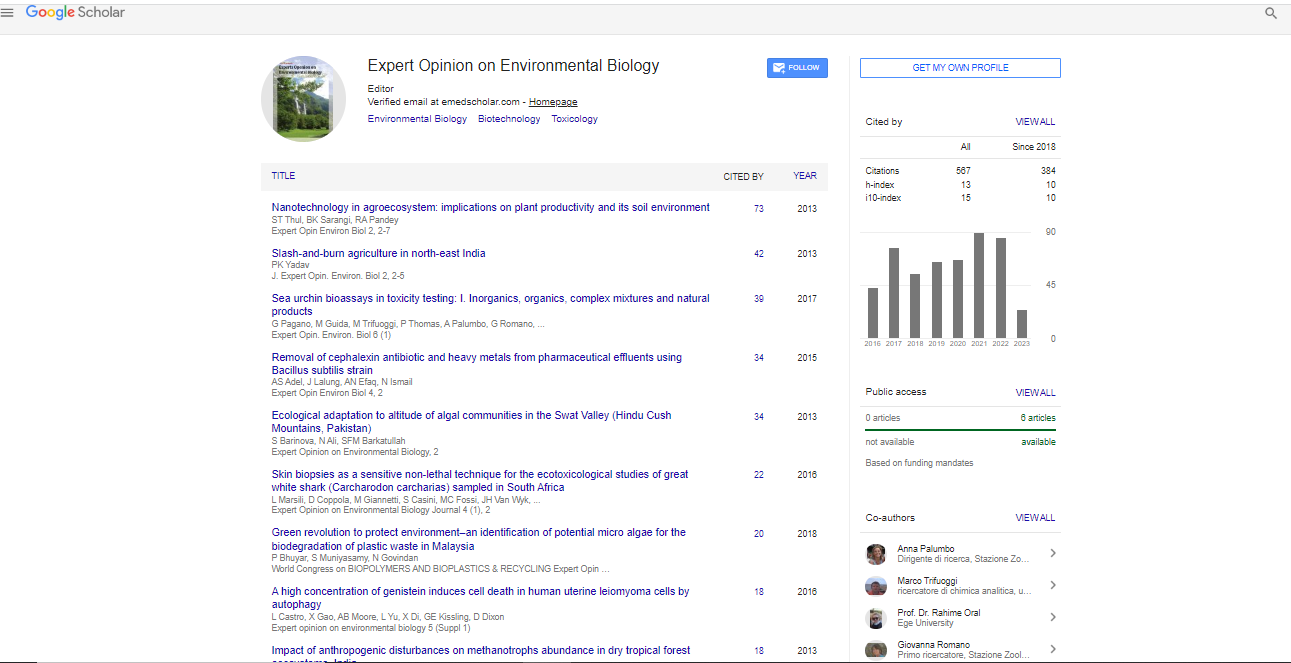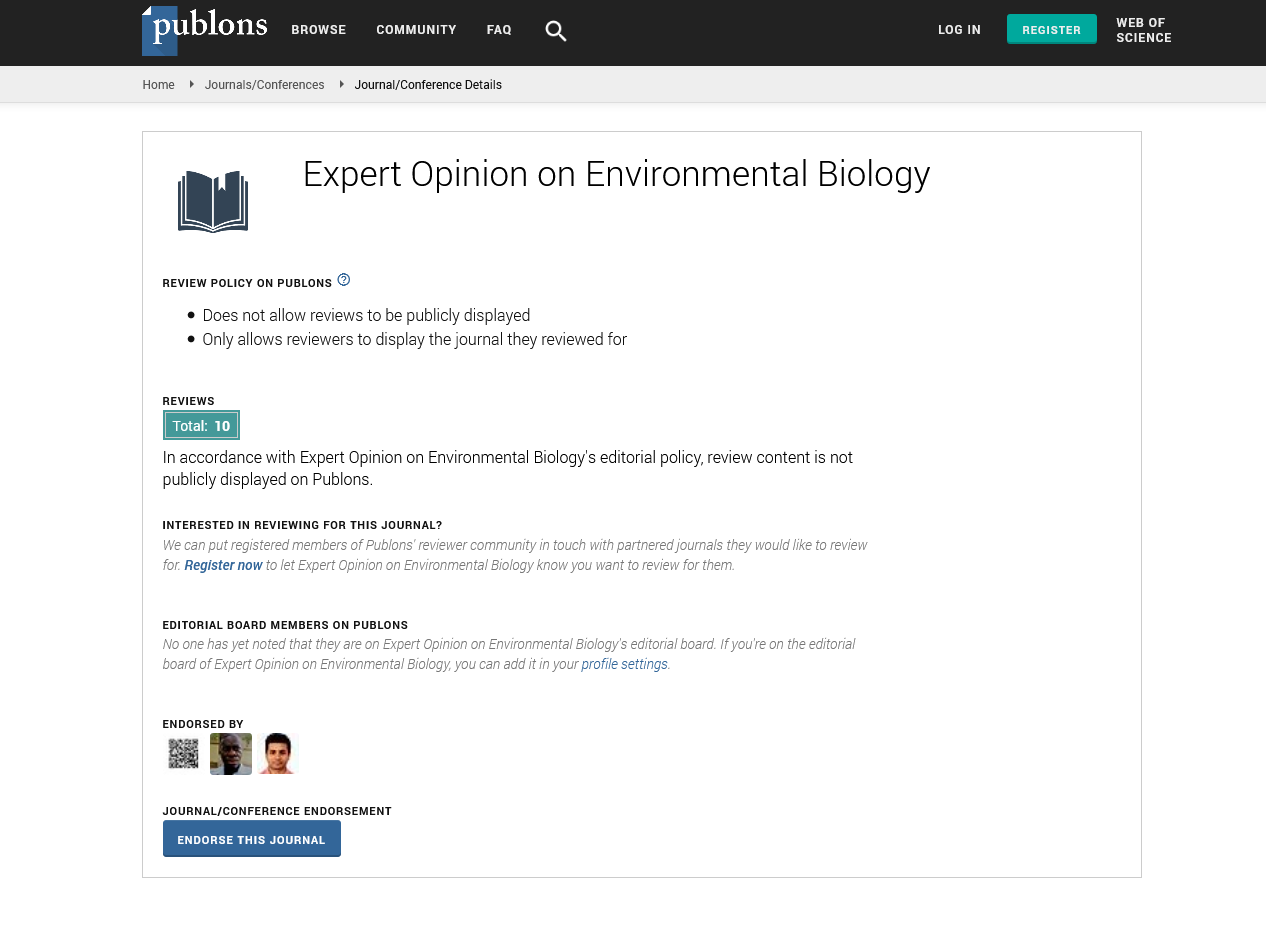Commentary, Expert Opin Environ Biol Vol: 14 Issue: 1
Assessing the Impact of Microplastics on Aquatic Ecosystems
Jeevenh Satrin*
Department of Environmental Science, Tezpur University, Tezpur, Assam, India
- *Corresponding Author:
- Jeevenh Satrin
Department of Environmental Science, Tezpur University, Tezpur, Assam, India
E-mail: runnan_chettri@ tu11.in
Received: 01-Mar-2025, Manuscript No. Eoeb-25-169973, Editor assigned: 03-Mar-2025, PreQC No. Eoeb-25-169973 (PQ), Reviewed: 17-Mar-2025, QC No. Eoeb-25-169973, Revised: 21-Mar-2025, Manuscript No. Eoeb-25- 169973 (R), Published: 28-Mar-2025, DOI: 10.4172/ 2325-9655.1000235
Citation: Jeevenh S (2025) Assessing the Impact of Microplastics on Aquatic Ecosystems. Expert Opin Environ Biol 14: 341
Copyright: © 2025 Jeevenh S. This is an open-access article distributed under the terms of the Creative Commons Attribution License, which permits unrestricted use, distribution and reproduction in any medium, provided the original author and source are credited.
Abstract
Microplastics have emerged as a significant pollutant in aquatic
environments, posing potential threats to biodiversity, ecosystem
health, and human well-being. This article reviews recent advances
in ecotoxicological research focusing on the sources, distribution,
and effects of microplastics in marine and freshwater ecosystems.
Emphasis is placed on understanding their interactions with chemical
pollutants, ingestion by aquatic organisms, and bioaccumulation
through food webs. The review also discusses innovative
methodologies for detecting and quantifying microplastics, along
with mitigation strategies aimed at reducing their environmental
footprint. Findings highlight the urgent need for standardized
monitoring protocols and integrated policy frameworks to address
this emerging ecological challenge.
Keywords: Microplastics; Ecotoxicology; Aquatic ecosystems; Bioaccumulation; Environmental pollution
Keywords
Microplastics; Ecotoxicology; Aquatic ecosystems; Bioaccumulation; Environmental pollution
Introduction
Microplastic pollution—plastic particles less than 5 mm in size—has been identified as a pervasive contaminant in global aquatic systems. These particles originate from the breakdown of larger plastics (secondary microplastics) or are directly manufactured at small sizes (primary microplastics) for industrial use. Due to their persistence and potential to adsorb toxic chemicals, microplastics represent a complex environmental problem that intersects biological, chemical, and physical domains. Ecotoxicology plays a crucial role in understanding their impacts, informing mitigation efforts, and protecting aquatic biodiversity [1].
Description
Microplastics enter aquatic ecosystems through multiple pathways, including wastewater discharge, stormwater runoff, and atmospheric deposition. Once in the water, their distribution is influenced by currents, wind, and particle density. In freshwater systems, they are often concentrated near urban and industrial areas, whereas in marine environments, they can be found from coastal zones to deep-sea sediments. Ecotoxicological research has revealed that microplastics can cause both physical and chemical harm to aquatic organisms. Physical effects include ingestion, leading to internal abrasions, false satiety, and reduced feeding efficiency. Chemically, microplastics can act as vectors for persistent organic pollutants (POPs), heavy metals, and other toxicants, which can be transferred into organisms upon ingestion. Laboratory experiments have demonstrated adverse effects on growth, reproduction, and survival in species ranging from plankton to fish [2].
One key concern is bioaccumulation and biomagnification through aquatic food webs. Studies indicate that microplastics and associated contaminants can move from prey to predators, potentially reaching humans through seafood consumption. Detection and quantification of microplastics require advanced analytical techniques, including Fourier-transform infrared spectroscopy (FTIR), Raman spectroscopy, and scanning electron microscopy (SEM). Standardization of these methods is critical for global data comparability. Mitigation strategies focus on reducing plastic production, improving waste management, and developing biodegradable alternatives. Policy initiatives, such as bans on microbeads and extended producer responsibility (EPR) programs, have shown promise but require broader international adoption [3].
Results
Recent field studies have confirmed widespread microplastic contamination in both developed and developing regions. Experimental data suggest that chronic exposure to microplastics can alter species behavior, metabolism, and immune function. Moreover, combined exposure to microplastics and chemical pollutants exacerbates toxicity, highlighting the importance of studying pollutant mixtures in ecotoxicology [4].
Discussion
Microplastic pollution represents a complex and multifaceted challenge in environmental biology. The interaction of microplastics with biological and chemical components of ecosystems requires interdisciplinary approaches combining ecology, chemistry, toxicology, and social science. While progress has been made in detecting and understanding their effects, significant knowledge gaps remain, especially regarding long-term ecological consequences and population-level impacts. Collaborative efforts between researchers, policymakers, and industry stakeholders are essential for effective management and mitigation [5].
Conclusion
Microplastics pose an emerging threat to aquatic ecosystems and, indirectly, to human health. Advancing ecotoxicological research, standardizing analytical methods, and implementing proactive policy measures are critical to mitigating this issue. The integration of scientific knowledge into legislative and public awareness frameworks will play a decisive role in reducing the environmental burden of microplastics.
References
- Smagghe G (2019) Management of Pest Insects and Plant Diseases by Non- Transformative RNAi. Plant Sci 10: 319.
- Petersen KF, Befroy D, Dufour S, Dziura J, Ariyan C, et al. (2003) Mitochondrial dysfunction in the elderly: possible role in insulin resistance. Science 300: 1140-1142.
- Koch A, Kogel K (2014) New wind in the sails: improving the agronomic value of crop plants through RNAi-mediated gene silencing. Plant Biotechnol J 12: 821-831.
- Cannata F, Vadalà G, Russo F, Papalia R, Napoli N, et al. (2020) Beneficial effects of physical activity in diabetic patients. J Funct Morphol Kinesiol 5: 70.
- Pumplin N, Sarazin A, Jullien PE, Bologna NG, Oberlin S, et al. (2016) DNA Methylation Influences the Expression of DICER-LIKE4 Isoforms, Which Encode Proteins of Alternative Localization and Function. Plant Cell 28: 2786-2804.
 Spanish
Spanish  Chinese
Chinese  Russian
Russian  German
German  French
French  Japanese
Japanese  Portuguese
Portuguese  Hindi
Hindi 
